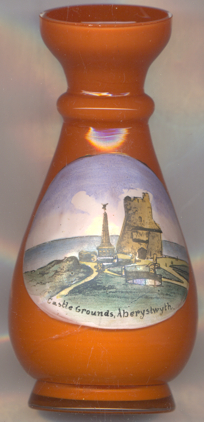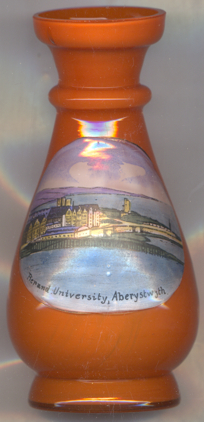

|
| UNITED KINGDOM OF GREAT BRITAIN AND NORTHERN IRELAND |
| Wales |
| Unitary Authority: Ceregidion / Cardiganshire |
Aberystwyth (“Mouth of the Ystwyth’) is a historic market town, administrative centre, and holiday resort within Ceredigion, West Wales, often colloquially known as Aber. It is located near the confluence of the rivers Ystwyth and Rheidol. Aberystwyth has a populaton of about 13,000 (2011).
The recorded history of Aberystwyth may be said to date from the building of a fortress in 1109 by Gilbert Fitz Richard (grandfather of Richard de Clare, known as Strongbow, the Cambro-Norman lord notable for his leading role in the Norman invasion of Ireland). In the early 15th century, the town was incorporated under the title of Ville de Lampadarn (the ancient name of the place being Llanbadarn Gaerog or the fortified Llanbadarn, to distinguish it from Llanbadarn Fawr, the village one mile (1.6 km) inland. It is thus styled in a Royal charter granted by Henry VIII but, by Elizabeth I’s time, the town was invariably named Aberystwyth in all documents. Rural industries and craftsmen were an important part of life in the town in the early 19th century. The Cambrian Railways line from Machynlleth reached Aberystwyth in 1864, closely followed by rail links to Carmarthen. The railway's arrival gave rise to something of a Victorian tourist boom and the town was once even billed as the “Biarritz of Wales”.

 Aberystwyth Castle [left, no. 3070] was built in 1277 by King Edward I after
the Welsh had destroyed Strongbow’s castle (which was located in a different location). Between the years 1404 and
1408 Aberystwyth Castle was in the hands of Owain Glyndwr but finally surrendered to Prince Harry (the future King
Henry V of England). In 1649, Parliamentarian troops razed the castle, so that its remains are now inconsiderable,
though portions of three towers still exist. In 1988, an excavation within the castle area revealed a complete male
skeleton, deliberately buried. Though skeletons rarely survive in Wales’ acidic soil, this skeleton was probably
preserved by the addition of lime from the collapsed building. Affectionately known as “Charlie” and now
housed in the Ceredigion Museum in the town, he probably dates from the English Civil War period, and is likely to have
died during the Parliamentarian siege. His image is featured in one of nine mosaics created to adorn the castle’s
walls.
Aberystwyth Castle [left, no. 3070] was built in 1277 by King Edward I after
the Welsh had destroyed Strongbow’s castle (which was located in a different location). Between the years 1404 and
1408 Aberystwyth Castle was in the hands of Owain Glyndwr but finally surrendered to Prince Harry (the future King
Henry V of England). In 1649, Parliamentarian troops razed the castle, so that its remains are now inconsiderable,
though portions of three towers still exist. In 1988, an excavation within the castle area revealed a complete male
skeleton, deliberately buried. Though skeletons rarely survive in Wales’ acidic soil, this skeleton was probably
preserved by the addition of lime from the collapsed building. Affectionately known as “Charlie” and now
housed in the Ceredigion Museum in the town, he probably dates from the English Civil War period, and is likely to have
died during the Parliamentarian siege. His image is featured in one of nine mosaics created to adorn the castle’s
walls.

 Aberystwyth University [near left, no. 3071: background left]
was founded in 1807 as ‘The University College of Wales’. Its building originally had been built
for the ‘Castle Hotel’, which, however, was never completed as a hotel but, following bankruptcy,
was sold cheaply to the Welsh National University Committee, a group of people dedicated to the creation of a
Welsh University. Today, the university has almost 8,000 students studying across its six academic Institutes.
Aberystwyth University [near left, no. 3071: background left]
was founded in 1807 as ‘The University College of Wales’. Its building originally had been built
for the ‘Castle Hotel’, which, however, was never completed as a hotel but, following bankruptcy,
was sold cheaply to the Welsh National University Committee, a group of people dedicated to the creation of a
Welsh University. Today, the university has almost 8,000 students studying across its six academic Institutes.
 Royal Pier [near left, no. 3071: foreground] was the first pier
to open in Wales. Commissioned by a consortium of local business people, the pier was designed and constructed by
noted pier-engineer Eugenius Birch. Opened on Good Friday in 1865, the 242 metres pier attracted 7,000 toll paying
visitors on its first day of opening, the same day that the Cambrian Railways line from Machynlleth officially opened.
However, this was the high point of the pier under its original owners, when seven months later in January 1866, a
severe storm washed away a 30 metres section at the seaward end. The original owners could not afford to replace the
lost section, and so sold the pier in 1872. The new owners replaced the lost section with a new 70 metres thinner section,
and built a new head gallery and refreshments stall. Around the start of the 20th century, a new glass pavilion designed
by George Croydon-Marks was added; opened in 1896, the pavilion could accommodate 3,000 people. In 1938, a storm with
estimated wind speeds of up to 90 mph (140 km/h) struck the town. Most of the promenade was destroyed, along with
61 metres of the pier, reducing its length by half. Repaired but not improved, it reopened after World War II, but
by the 1970s again was in a bad state of repair so that it was closed. In 1979, Aberystwyth Royal Pier was purchased by
the Don Leisure Group, and in 1986 they spent
Royal Pier [near left, no. 3071: foreground] was the first pier
to open in Wales. Commissioned by a consortium of local business people, the pier was designed and constructed by
noted pier-engineer Eugenius Birch. Opened on Good Friday in 1865, the 242 metres pier attracted 7,000 toll paying
visitors on its first day of opening, the same day that the Cambrian Railways line from Machynlleth officially opened.
However, this was the high point of the pier under its original owners, when seven months later in January 1866, a
severe storm washed away a 30 metres section at the seaward end. The original owners could not afford to replace the
lost section, and so sold the pier in 1872. The new owners replaced the lost section with a new 70 metres thinner section,
and built a new head gallery and refreshments stall. Around the start of the 20th century, a new glass pavilion designed
by George Croydon-Marks was added; opened in 1896, the pavilion could accommodate 3,000 people. In 1938, a storm with
estimated wind speeds of up to 90 mph (140 km/h) struck the town. Most of the promenade was destroyed, along with
61 metres of the pier, reducing its length by half. Repaired but not improved, it reopened after World War II, but
by the 1970s again was in a bad state of repair so that it was closed. In 1979, Aberystwyth Royal Pier was purchased by
the Don Leisure Group, and in 1986 they spent
[https://en.wikipedia.org/wiki/Aberystwyth, https://en.wikipedia.org/wiki/Aberystwyth_University,
https://en.wikipedia.org/wiki/Royal_Pier,_Aberystwyth]
![[scale]](lineal.jpg)